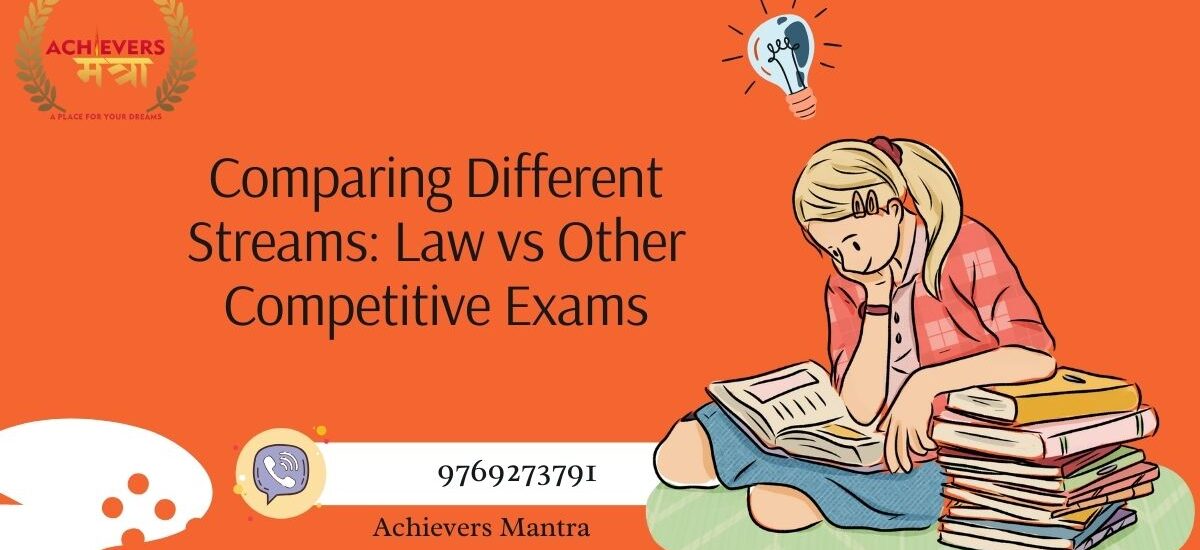Comparing Different Streams: Law vs Other Competitive Exams- In the landscape of higher education and career advancement, the decision to pursue a competitive exam often marks a significant milestone in one’s academic journey. However, when it comes to choosing between different streams of competitive exams, such as law versus others, aspirants are often confronted with a myriad of considerations. In this insightful blog post, we embark on a journey of exploration and comparison, shedding light on the distinctiveness of various streams of competitive exams. With our main focus keyword “Comparing Different Streams: Law vs Other Competitive Exams,” we’ll delve into the nuances of law entrance exams and juxtapose them with other competitive exams across diverse fields. Let’s navigate the complexities and opportunities presented by these contrasting streams to help aspiring candidates make informed decisions about their academic and professional futures.
Also Check: 10 Essential Tips for Acing Law Entrance Exams
Understanding Law Entrance Exams
Law entrance exams stand out as a unique category within the realm of competitive examinations, characterized by their focus on assessing candidates’ aptitude for legal studies and practice. In this section, we’ll delve into the distinctive features of law entrance exams and their significance in the field of legal education:
- Format and Structure:
- Discuss the format and structure of popular law entrance exams such as CLAT (Common Law Admission Test), LSAT (Law School Admission Test), and AILET (All India Law Entrance Test).
- Highlight the sections typically included in law entrance exams, such as legal reasoning, logical reasoning, English comprehension, general knowledge, and current affairs.
- Syllabus Coverage:
- Explore the syllabus coverage of law entrance exams, which encompasses a diverse range of subjects relevant to the study and practice of law.
- Discuss the emphasis placed on areas such as legal aptitude, constitutional law, contract law, criminal law, torts, and legal reasoning skills.
- Eligibility Criteria:
- Outline the eligibility criteria for appearing in law entrance exams, including educational qualifications, age limits, and nationality requirements.
- Discuss any specific prerequisites or conditions set forth by individual exam conducting bodies.
- Scope and Career Opportunities:
- Highlight the scope and career opportunities available to aspirants who clear law entrance exams, including opportunities in legal practice, corporate law, litigation, government services, academia, and advocacy.
By understanding the format, syllabus, eligibility criteria, and career prospects associated with law entrance exams, aspirants can gain valuable insights into the unique characteristics of this stream of competitive examinations. Let’s now explore an overview of other competitive exams across different fields for a comprehensive comparison.
Overview of Other Competitive Exams
While law entrance exams occupy a prominent position in the realm of competitive examinations, they are just one facet of a diverse landscape that encompasses various streams and fields of study. In this section, we’ll provide an overview of other competitive exams across different fields:
- Engineering Entrance Exams:
- Discuss popular engineering entrance exams such as JEE Main (Joint Entrance Examination), JEE Advanced, and state-level engineering entrance tests.
- Highlight the focus on subjects such as physics, chemistry, mathematics, and engineering aptitude, along with practical and analytical skills.
- Medical Entrance Exams:
- Explore medical entrance exams like NEET (National Eligibility cum Entrance Test) for undergraduate and postgraduate medical courses.
- Discuss the emphasis on biology, chemistry, physics, and aptitude for medical studies, along with practical skills and clinical knowledge.
- Management Entrance Exams:
- Outline management entrance exams such as CAT (Common Admission Test), XAT (Xavier Aptitude Test), and MAT (Management Aptitude Test).
- Highlight the focus on verbal ability, quantitative aptitude, data interpretation, logical reasoning, and general awareness, along with managerial skills and decision-making abilities.
- Civil Services Exams:
- Explore civil services exams conducted by UPSC (Union Public Service Commission) for recruitment to various administrative and governmental positions.
- Discuss the comprehensive syllabus covering subjects such as history, geography, polity, economy, current affairs, and aptitude for administrative roles.
- Other Competitive Exams:
- Mention other competitive exams in diverse fields such as banking, defense services, public sector undertakings (PSUs), and academic scholarships.
- Highlight the varying formats, syllabi, and career paths associated with these exams, catering to different interests, aptitudes, and aspirations.
By providing an overview of other competitive exams in fields such as engineering, medicine, management, civil services, and beyond, aspirants can gain a holistic understanding of the diverse opportunities available in the competitive examination landscape. Let’s now compare and contrast the structure and syllabus of law entrance exams with other competitive exams for a deeper analysis.
Also Check: Exploring Career Options After Clearing Law Entrance Exams
Differences in Exam Structure and Syllabus
The structure and syllabus of competitive exams vary significantly across different streams, reflecting the distinct requirements and objectives of each field. In this section, we’ll compare and contrast the structure and syllabus of law entrance exams with other competitive exams:
- Law Entrance Exams:
- Discuss the format of law entrance exams, typically comprising multiple-choice questions (MCQs) or objective-type questions.
- Highlight the unique sections included in law entrance exams, such as legal reasoning, logical reasoning, English comprehension, general knowledge, and current affairs.
- Emphasize the focus on assessing candidates’ understanding of legal concepts, reasoning abilities, and awareness of contemporary legal issues.
- Engineering and Medical Entrance Exams:
- Compare the format and structure of engineering and medical entrance exams, which often feature MCQs based on subjects such as physics, chemistry, biology, and mathematics.
- Note the absence of specific sections related to legal reasoning or general knowledge in engineering and medical entrance exams, as the focus is primarily on scientific knowledge and problem-solving skills.
- Management Entrance Exams:
- Contrast the syllabus of management entrance exams with that of law entrance exams, highlighting the emphasis on verbal ability, quantitative aptitude, data interpretation, and logical reasoning.
- Discuss the inclusion of sections such as reading comprehension, data sufficiency, and business awareness, which are tailored to assess candidates’ managerial aptitude and decision-making skills.
- Civil Services Exams:
- Analyze the structure of civil services exams, which comprise multiple stages including preliminary, mains, and interview rounds.
- Discuss the comprehensive syllabus covering subjects such as history, geography, polity, economy, current affairs, and aptitude for administrative roles, reflecting the diverse responsibilities of civil servants.
By comparing the structure and syllabus of law entrance exams with other competitive exams, aspirants can gain insights into the specific requirements and expectations of each field. Understanding these differences is essential for making informed decisions about exam preparation and career paths. Let’s now explore the career opportunities and trajectories associated with pursuing law versus other competitive exams for a comprehensive analysis.
Career Opportunities and Trajectories
The choice between different streams of competitive exams not only influences academic pursuits but also shapes future career opportunities and trajectories. In this section, we’ll explore the diverse career paths available to aspirants who clear law entrance exams compared to other competitive exams:
- Legal Profession:
- Discuss the career opportunities available to law graduates, including legal practice, litigation, corporate law, public interest law, and academia.
- Highlight the versatility of a law degree, which equips individuals with transferable skills such as critical thinking, research abilities, and communication proficiency.
- Engineering and Technology:
- Explore career paths in engineering and technology sectors, including roles in software development, mechanical engineering, civil engineering, electronics, and telecommunications.
- Discuss the demand for engineers in various industries such as IT, manufacturing, construction, and infrastructure development.
- Medicine and Healthcare:
- Highlight career opportunities in medicine and healthcare, encompassing roles as doctors, surgeons, specialists, nurses, pharmacists, and healthcare administrators.
- Discuss the significance of medical professionals in promoting public health, disease prevention, and patient care.
- Management and Business Administration:
- Explore career trajectories in management and business administration, including roles in corporate management, finance, marketing, human resources, and entrepreneurship.
- Discuss the potential for career advancement and leadership roles in diverse industries and sectors.
- Civil Services and Government Services:
- Analyze career opportunities in civil services and government services, encompassing roles in administrative services, diplomatic services, law enforcement, and public policy.
- Discuss the impact of civil servants in governance, policy formulation, and public service delivery.
By comparing the career opportunities and trajectories associated with law versus other competitive exams, aspirants can gain insights into the professional pathways available in each field. Understanding these career prospects is essential for making informed decisions about academic pursuits and future aspirations. Let’s now explore the factors to consider when deciding between law and other competitive exams for a comprehensive analysis.
Also Check: Effective Time Management for Law and Competitive Exams
Factors to Consider in Decision Making
When faced with the decision to choose between law and other competitive exams, aspirants must consider various factors that align with their interests, aptitudes, and career goals. In this section, we’ll explore key factors to consider in decision-making:
- Personal Interests and Passions:
- Headings: Personal Interests and Passions
- Description: Encourage aspirants to reflect on their personal interests, passions, and strengths when selecting a competitive exam stream. Emphasize the importance of pursuing a career path aligned with one’s intrinsic motivations and aspirations.
- Academic Aptitude and Skills:
- Headings: Academic Aptitude and Skills
- Description: Discuss the relevance of academic aptitude and skills in determining suitability for different competitive exam streams. Encourage aspirants to assess their strengths in subjects such as law, science, mathematics, or humanities to make an informed decision.
- Career Goals and Aspirations:
- Headings: Career Goals and Aspirations
- Description: Highlight the significance of aligning competitive exam choices with long-term career goals and aspirations. Encourage aspirants to envision their desired career trajectories and evaluate how each exam stream contributes to their professional growth and fulfillment.
- Market Demand and Trends:
- Headings: Market Demand and Trends
- Description: Analyze market demand and trends in various industries and sectors to identify emerging opportunities and areas of growth. Encourage aspirants to consider the demand for professionals in fields such as law, engineering, healthcare, management, and civil services.
- Work-Life Balance and Lifestyle Preferences:
- Headings: Work-Life Balance and Lifestyle Preferences
- Description: Discuss the importance of work-life balance and lifestyle preferences in career decision-making. Encourage aspirants to assess factors such as job flexibility, work environment, location, and remuneration when evaluating career options.
- Professional Growth and Development:
- Headings: Professional Growth and Development
- Description: Emphasize the significance of continuous learning, skill development, and career advancement in professional growth. Encourage aspirants to choose a competitive exam stream that offers opportunities for personal and professional development aligned with their aspirations.
By considering these factors in decision-making, aspirants can make informed choices about which competitive exam stream best aligns with their interests, aptitudes, and career goals. Let’s now conclude our exploration of comparing different streams of competitive exams with a summary of key insights and actionable takeaways.
Conclusion: Comparing Different Streams of Competitive Exams
As we conclude our comprehensive exploration of comparing different streams of competitive exams, it becomes evident that the decision to choose between law and other competitive exams is a pivotal moment in one’s academic and professional journey. Let’s summarize the key insights and actionable takeaways from our discussion:
- Understanding the Unique Characteristics:
- Emphasize the importance of understanding the unique characteristics, format, and syllabus of each competitive exam stream, including law, engineering, medicine, management, and civil services.
- Exploring Career Opportunities:
- Highlight the diverse career opportunities and trajectories available in each field, ranging from legal practice and engineering to medicine, management, and civil services.
- Factors to Consider in Decision Making:
- Discuss the critical factors that aspirants should consider when making decisions about competitive exam choices, including personal interests, academic aptitude, career goals, market demand, work-life balance, and professional growth.
- Aligning Choices with Aspirations:
- Encourage aspirants to align their exam choices with their long-term aspirations, ensuring that their chosen career paths reflect their passions, strengths, and values.
- Continuous Learning and Development:
- Stress the importance of continuous learning, skill development, and career advancement in achieving professional success and fulfillment, regardless of the chosen exam stream.
By considering these insights and factors, aspirants can navigate the complexities of comparing different streams of competitive exams and make informed decisions that set them on a path toward a fulfilling and rewarding career. We hope this blog post has provided valuable insights and guidance to aspiring candidates as they embark on their academic and professional endeavors. Here’s to your success in your chosen path!





